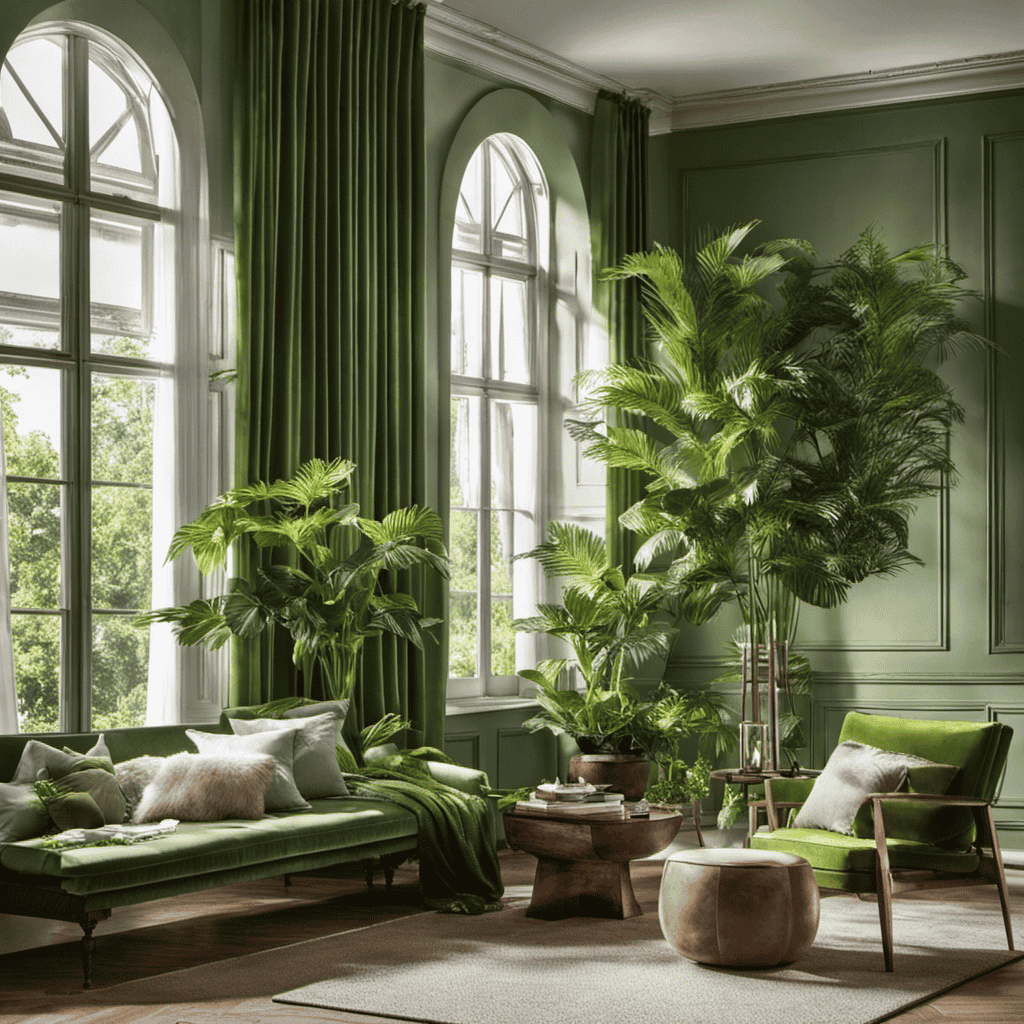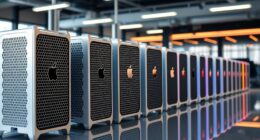Did you know that indoor air can be up to five times more polluted than outdoor air? That’s why it’s crucial to have an air purifier equipped with an infrared dust sensor to ensure clean and healthy air in your home.
In this article, I will explain what an infrared dust sensor does and how it works in an air purifier. We will explore the benefits of using this technology and provide tips for choosing the right air purifier with an infrared dust sensor.
So, let’s dive in and discover the power of infrared technology in air purification.
Key Takeaways
- Infrared dust sensors use infrared technology to detect and measure particles in the air.
- They provide real-time data on air quality and enable automatic adjustment of cleaning settings and filter replacement indication.
- Using an infrared dust sensor enhances the air purification process and improves indoor air quality.
- These sensors play a crucial role in effectively targeting and removing pollutants, optimizing air purifier performance and efficiency.
Understanding Infrared Technology
To understand infrared technology, you can think of it as a method that uses infrared light to detect and measure various particles in the air.
Infrared technology has several advantages that make it a valuable tool in many applications. Firstly, it is non-invasive, meaning it can detect particles without physically touching them. This makes it ideal for use in sensitive environments, such as hospitals or laboratories.
Additionally, infrared technology is highly accurate and can provide real-time measurements, allowing for quick analysis and decision-making. It is also versatile, as it can be used to detect a wide range of particles, including dust, pollutants, and even gases. This makes it useful in various industries, such as air quality monitoring, industrial safety, and even in home appliances like air purifiers.
Overall, infrared technology offers numerous benefits and has a wide range of applications in detecting and measuring particles in the air.
How an Infrared Dust Sensor Works
An infrared dust sensor determines the level of particles in the air, helping the purifier to efficiently clean the environment. This technology is widely used in air purifiers to provide accurate readings of dust and other airborne particles.
Here are four key applications of infrared dust sensor technology:
-
Particle Detection: The infrared sensor detects the presence of particles in the air by measuring the light scattered by these particles. It can distinguish between different particle sizes, allowing the purifier to target specific pollutants.
-
Air Quality Monitoring: By continuously monitoring particle levels, the sensor provides real-time data on the air quality in the surrounding environment. This information helps users understand the effectiveness of the purifier and make informed decisions about air purification.
-
Automatic Operation: The sensor enables the purifier to automatically adjust its cleaning settings based on the detected particle levels. This ensures optimal performance and energy efficiency.
-
Filter Replacement Indication: The sensor can also track the accumulation of dust and particles on the purifier’s filters. It then alerts the user when it’s time to replace the filters, ensuring the purifier maintains its effectiveness.
Benefits of Using an Infrared Dust Sensor
When it comes to air purification, using an infrared dust sensor can provide several benefits.
Firstly, it enhances the air purification process by effectively detecting and eliminating dust particles in the air. This not only improves indoor air quality but also ensures efficient dust detection, preventing it from circulating and causing respiratory issues.
Enhanced Air Purification
The enhanced air purification feature on our air purifier utilizes an infrared dust sensor. This advanced technology allows the air purifier to efficiently detect and remove dust particles from the air, ensuring a cleaner and healthier environment. Here are four reasons why the infrared dust sensor in our air purifier is a cost-effective and energy-efficient solution:
-
Precision: The infrared sensor precisely detects even the smallest dust particles, ensuring thorough purification and preventing them from recirculating in the air.
-
Energy Efficiency: By using an infrared dust sensor, our air purifier optimizes its operation, conserving energy and reducing electricity consumption. This makes it an energy-efficient choice for long-term use.
-
Cost Savings: With its energy-efficient operation, our air purifier helps reduce electricity bills. This makes it a cost-effective solution for maintaining clean indoor air quality.
-
Extended Filter Life: The infrared dust sensor allows the air purifier to automatically adjust its purification settings based on the detected dust levels. This not only ensures optimal performance but also extends the lifespan of the filters. As a result, it reduces maintenance and replacement costs.
Improved Indoor Air Quality
To improve your indoor air quality, consider utilizing our air purifier with enhanced air purification technology.
Airborne pollutants can have a detrimental impact on our health, causing respiratory issues, allergies, and even long-term diseases.
Our air purifier is designed to remove these pollutants, providing numerous health benefits. With advanced filtration systems and powerful fans, it effectively captures and eliminates dust, pollen, pet dander, mold spores, and other harmful particles present in the air.
By reducing these airborne pollutants, our air purifier helps to alleviate symptoms and improve overall respiratory health. Breathing cleaner air can also enhance sleep quality and boost productivity.
Invest in our air purifier today and experience the positive impact it can have on your indoor air quality and well-being.
Efficient Dust Detection
When it comes to improving indoor air quality, efficient dust detection is crucial. Air purifiers equipped with infrared dust sensors play a vital role in detecting and monitoring airborne pollutants.
Here’s how they work:
-
Infrared Technology: Infrared sensors use advanced technology to detect and measure dust particles in the air. They emit infrared light and analyze the scattered light to determine the concentration of particles.
-
Accurate Detection: These sensors can accurately detect and differentiate between different sizes of dust particles, from fine particles to larger ones. This helps in understanding the level of air pollution present.
-
Real-Time Monitoring: By continuously monitoring the air, infrared dust sensors provide real-time data about the presence and concentration of airborne pollutants. This information enables users to take immediate actions to improve indoor air quality.
-
Automated Purification: Air purifiers with infrared dust sensors can automatically adjust their purification settings based on the detected dust levels, ensuring efficient and effective removal of pollutants from the air.
The Role of Infrared Dust Sensors in Air Purifiers
As someone who values clean and fresh air, I believe it’s important to discuss the role of infrared dust sensors in air purifiers.
These sensors play a crucial role in detecting airborne particles, allowing the air purifier to effectively target and remove pollutants from the air.
Detecting Airborne Particles
The infrared dust sensor in the air purifier detects airborne particles and helps improve indoor air quality. Here are four ways it achieves this:
-
Accurate Detection: The infrared dust sensor uses advanced technology to identify and measure the presence of airborne contaminants. It can detect a wide range of particles, including dust, pollen, pet dander, and mold spores.
-
Real-time Monitoring: The sensor continuously monitors the air quality, providing real-time feedback on the levels of particles present. This allows the air purifier to adjust its settings accordingly and effectively remove the pollutants from the air.
-
Automatic Operation: With the infrared dust sensor, the air purifier can automatically detect when there is a high concentration of particles in the air. It then activates the purification process to ensure that the air remains clean and healthy.
-
Enhanced Efficiency: By accurately detecting airborne particles, the infrared dust sensor optimizes the performance of the air purifier. It ensures that the purifier is only working when necessary, saving energy and extending the lifespan of the device.
Improving Air Quality
One way to enhance the quality of the air is by using an air purifier with an infrared dust sensor. This technology plays a crucial role in air pollution control and offers numerous health benefits.
An infrared dust sensor is designed to detect and measure the amount of dust particles present in the air. It works by emitting infrared light and analyzing the reflections to determine the concentration of particles. By continuously monitoring the air, the sensor can alert the purifier to increase or decrease its filtration power accordingly. This ensures that the air you breathe is clean and free from harmful pollutants.
In addition to improving air quality, using an air purifier with an infrared dust sensor can help reduce allergies, respiratory issues, and improve overall well-being.
Enhancing Filtration Efficiency
Using an air purifier with an infrared dust sensor helps to improve the filtration efficiency and ensures cleaner, healthier air. The infrared dust sensor is a crucial component of the air purifier as it detects and monitors the presence of dust particles in the air.
Here are four ways in which an infrared dust sensor enhances filtration effectiveness and dust elimination:
-
Real-time detection: The sensor continuously monitors the air for dust particles, allowing the purifier to adjust its filtration settings accordingly.
-
Precise targeting: By accurately identifying the size and concentration of dust particles, the sensor enables the purifier to target and eliminate specific pollutants effectively.
-
Automatic operation: With the infrared dust sensor, the air purifier can automatically adjust its filtration speed and intensity based on the detected dust levels.
-
Improved performance: The sensor ensures that the air purifier operates at its optimal capacity, maximizing its filtration effectiveness and overall efficiency.
Incorporating an infrared dust sensor in an air purifier is a practical way to enhance the filtration process, resulting in cleaner air and improved respiratory health.
Factors to Consider When Choosing an Air Purifier With Infrared Dust Sensor
When choosing an air purifier with an infrared dust sensor, there are a few factors to consider.
The first factor is the sensitivity of the infrared technology. A highly sensitive sensor will detect even the tiniest particles of dust, ensuring a cleaner and healthier indoor environment.
Another factor to consider is the range of the sensor. A wider range means that the sensor can cover a larger area, making it more effective in purifying the air in your home.
Lastly, you should also consider the durability and reliability of the sensor. A good quality sensor will last longer and require less maintenance.
With these factors in mind, you can choose an air purifier with an infrared dust sensor that meets your specific needs.
Now, let’s move on to the next section and learn about maintenance and cleaning tips for infrared dust sensors.
Maintenance and Cleaning Tips for Infrared Dust Sensors
Now that we’ve discussed the factors to consider when choosing an air purifier with an infrared dust sensor, let’s move on to the maintenance and cleaning tips for these sensors.
As an owner of an air purifier with an infrared dust sensor, it’s important to keep it in good working condition to ensure optimal performance. Here are some maintenance tips and a troubleshooting guide for infrared dust sensors:
-
Regular cleaning: Dust and debris can accumulate on the sensor over time, so it’s essential to clean it regularly. Use a soft cloth or brush to gently wipe away any dirt.
-
Avoid moisture: Infrared dust sensors are sensitive to moisture, so make sure to keep them away from any liquids or high humidity areas.
-
Check for obstructions: Occasionally, check if there are any obstructions blocking the sensor’s line of sight. Clear away any objects that might hinder its performance.
-
Troubleshooting: If you notice that the sensor is not functioning properly, try resetting your air purifier or consult the user manual for specific troubleshooting instructions.
Comparing Infrared Dust Sensors to Other Air Purification Technologies
If you want to compare infrared dust sensors to other technologies, consider the effectiveness, cost, and maintenance requirements of each option. When it comes to air purification, two popular choices are infrared dust sensors and HEPA filters. While both options are effective in removing allergens from the air, there are some differences to consider.
| Infrared Dust Sensors | HEPA Filters | |
|---|---|---|
| Effectiveness | Effectively detects and removes dust particles and allergens. | Highly effective in capturing microscopic particles such as pollen, pet dander, and dust mites. |
| Cost | Relatively affordable compared to other technologies. | Can be more expensive due to the need for filter replacements. |
| Maintenance | Low maintenance as they do not require regular filter replacements. | Requires regular filter replacements to maintain effectiveness. |
Infrared dust sensors are known for their ability to detect and remove dust particles and allergens effectively. They are relatively affordable compared to HEPA filters, which can be more expensive due to the need for filter replacements. In terms of maintenance, infrared dust sensors require low maintenance as they do not require regular filter replacements, while HEPA filters need regular filter replacements to maintain their effectiveness. Overall, both options are effective in removing allergens, but infrared dust sensors offer a more cost-effective and low-maintenance solution.
Frequently Asked Questions
Can an Infrared Dust Sensor Effectively Detect All Types of Dust Particles?
Yes, an infrared dust sensor can effectively detect many types of dust particles, but it may have potential limitations in detecting certain smaller particles. Alternative detection methods like laser particle counters can be used for more accurate results.
How Does an Infrared Dust Sensor Contribute to Improving Air Quality?
Using an infrared dust sensor in an air purifier is like having a sharp-eyed detective that spots hidden dust particles. It plays a crucial role in improving air quality by detecting and capturing even the tiniest particles, ensuring cleaner and healthier air for you to breathe.
Are There Any Potential Health Risks Associated With Using an Air Purifier With an Infrared Dust Sensor?
There may be potential health risks associated with using an air purifier with an infrared dust sensor. However, the effectiveness of the sensor in improving air quality outweighs these risks.
Can an Infrared Dust Sensor Accurately Distinguish Between Dust and Other Airborne Particles?
Can an infrared dust sensor accurately distinguish between dust and other airborne particles? Yes, infrared sensors use advanced dust sensing technology to effectively differentiate between dust and other particles, ensuring efficient air purification.
Do All Air Purifiers With an Infrared Dust Sensor Have the Same Level of Efficiency in Removing Dust Particles From the Air?
All air purifiers with an infrared dust sensor do not have the same level of efficiency in removing dust particles from the air. The effectiveness of different air purifier sensors varies based on the technology used.
Conclusion
After learning about the wonders of infrared dust sensors in air purifiers, I can’t help but feel amazed by how technology has advanced. It’s incredible how these sensors can detect even the tiniest dust particles, ensuring cleaner and healthier air for us to breathe.
The benefits of using infrared dust sensors are undeniable, from improved air quality to reduced allergies. When choosing an air purifier, considering one with this technology is a no-brainer. Just imagine, with an infrared dust sensor, you can enjoy a home that feels fresh and rejuvenating every day.
It’s truly remarkable.










